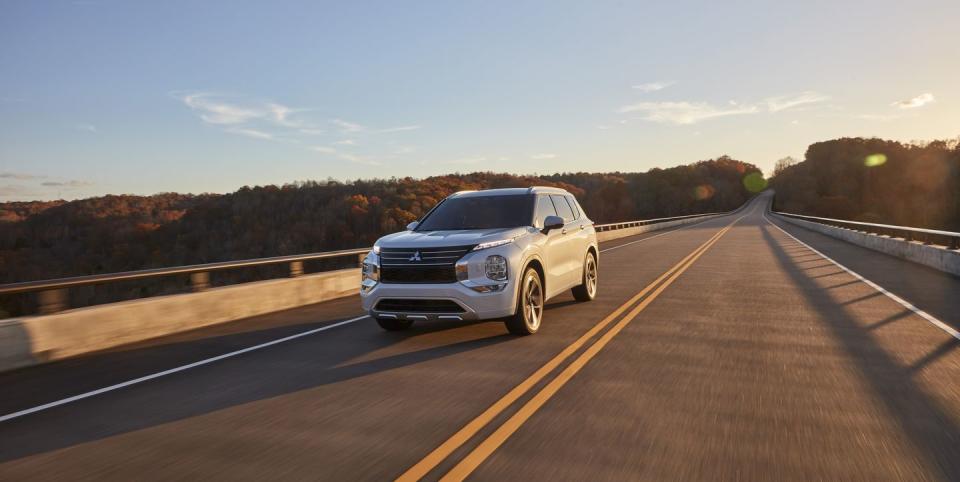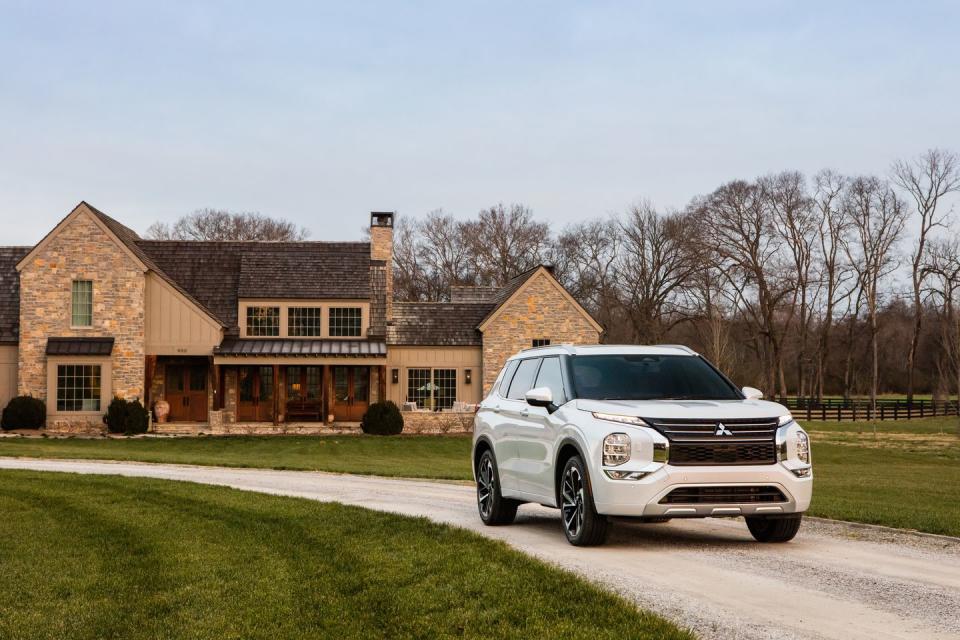2022 Outlander Is the Comfortable, Stylish Future of Mitsubishi

New Mitsubishi Outlander rides on Nissan Rogue mechanicals and is powered by a Nissan Rogue four-cylinder.
Styling both outside and in is all Mitsubishi, though.
CUVs are taking over the Earth.
It has been 22 years since Renault and Nissan joined forces, and five years since the pair took a controlling interest in Mitsubishi. The alliance also includes Infiniti, Dacia, Samsung Motors, Datsun, Alpine, Lada and some carmaker called Venucia, the latter being, of course, a subsidiary of the Dongfeng Nissan Passenger Vehicle Company, as if I had to tell you that. Forming an alliance like this means each carmaker can share parts, platforms and personalities and thus save big bucks, passing the savings on to you! (Or maybe just passing the savings on to shareholders and totally hosing you. Ha ha, Who knows?)
So, among the many benefits of all that cooperation is that the new Mitsubishi Outlander shares a platform and a powertrain with the Nissan Rogue. Now, before you start whining about that, or waving your arms in outrage and ripping off tersely worded ALL CAPS comments in the comments section about “WHY DON’T THEY BRING BACK THE DELICA, MAN????,” just be thankful they didn’t use the Venucia D60 or Dongfeng Fengdu MX6 platforms (don’t get me started on those heaps).
The Rogue is a mighty popular compact crossover utility vehicle, the number-three seller in the compact CUV segment here in the U.S. and the number-one-selling Nissan. So if you have to platform share, Mitsubishi really did get the best, at least in the opinion of many American buyers who, as I said, prefer the Rogue to all but two other compact SUVs.

In fact, here is what my favorite Mitsubishi spokesman said when asked about this particular piece of platform-sharing:
“It is indeed a shared engineering platform developed by the member companies of the Renault-Nissan-Mitsubishi Alliance,” he began, sounding like he was running for office or something. “The way the Outlander feels and drives is very specific to this vehicle however – suspension tuning, tire size and brand choice, etc. Given Mitsubishi’s long heritage of AWD experience (WRC and Dakar wins though the years), the Super All-Wheel Control system is very specific to us. Driver feel and feedback was critical to the development of the car, and the engineering team spent a lot of time on this.”
And, of course, there’s the styling, which you could even say surpasses that of the Nissan equivalent.
“Styling inside and out are 100% specific to Mitsubishi, and the vehicle is built in our factory in Okazaki, Japan. And we are the only car in the compact SUV segment with a third row as standard.”
The Volkswagen Tiguan's third row is optional, remember?
So, after all that, what, exactly will those buyers get when the new Outlander goes on sale in April?
Firstly, the Rogue engine. Power comes from the Rogue’s 2.5-liter four, “newly developed by the alliance,” making 181 hp and 181 lb ft of torque. Those figures are improvements over the previous Outlander of 8.9 percent, by the way, so you’re getting more power and torque in the new vehicle. The increase is across the rev range, too, from down low to up high.
That engine is mated to a CVT transmission with eight of those fake gear change “steps,” but the steps allow for a sport mode to keep the transmission at a more responsive engine speed.
The Outlander is available in front- or S-AWC all-wheel drive, each offering six different drive modes: Eco, Normal, Tarmac, Gravel, Snow and Mud. S-AWC uses sensors to detect the steering angle, yaw rate, driving torque, brake pressure, wheel speed, and other factors to “continuously and correctly identify driver operation and vehicle status.” It might remind you of Mitsubishi’s rich history in rallying, maybe. Use your imagination.
The electric power steering features dual pinions, each mounted outboard on the steering rack as close as possible to the wheels for greater accuracy. The aluminum suspension is struts in front and a multilink coil spring setup in the rear, with increased stiffness overall compared to the previous Outlander.
Inside looks downright luxurious, at least in the higher trim levels they gave us for photos, with the now-all-important diamond-quilted seats and nice contrasting trim throughout. That rearmost seat is quite an accomplishment given the Outlander’s 185.4 inches overall and 106.5-inch wheelbase. The third row seating is standard, the only such offering in the segment – the Tiguan offers it as an option.
Pricing will start at $26,990, almost a grand more than the previous model and almost the same price as the Rogue. But for that you get what is arguably a more stylish exterior and interior, as much power as almost all buyers are realistically ever going to want, and that third row standard. So while no one is saying you should not give up your demand for a return of the Delica, or the Evo, 3000 GT VR4, Eclipse or even a Galant, the market has long left those models behind, sunk in unprofitability. The future, the foreseeable future, is compact crossovers, so you might as well buy one that looks cool and seats seven.
But I do long for the Delica… okay, enough!

 Yahoo Autos
Yahoo Autos 